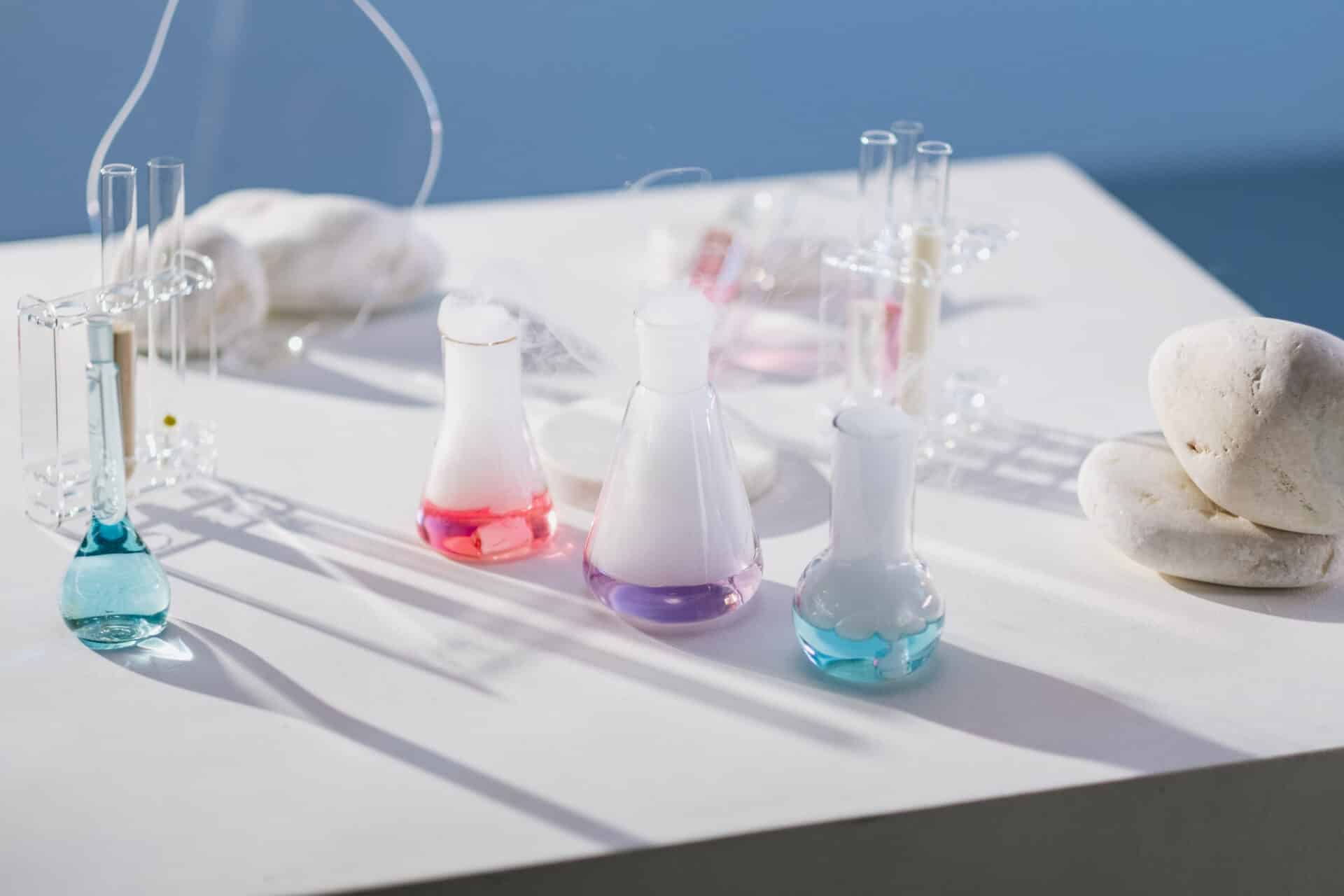Boiling chips are added to the distillation flask to help disperse the heat of the boiling liquid more evenly. By dispersing the heat, it prevents local hot spots from forming, which can lead to product loss or even equipment damage. Boiling chips also help prevent bumping or frothing during a distillation process which can cause contamination and poor product quality. Boiling chips also help ensure that the vaporization rate of the liquid is consistent.Boiling chips are small pieces of unglazed, porous ceramic material used in laboratory processes. They are typically added to a boiling liquid to reduce bumping. Bumping occurs when a liquid rapidly boils and forms vapor pockets that cause the mixture to foam up and boil over. Boiling chips act as nucleation sites for the formation of vapor bubbles, which helps to keep the solution from boiling over. Boiling chips can also be used in distillation and refluxing applications.
How Boiling Chips Help in Distillation
Boiling chips are small pieces of inert material that are added to liquids during distillation to increase the rate of evaporation. They help promote uniform heating and reduce local hot spots, which can cause the liquid to boil unevenly or even explode. Boiling chips also provide a greater surface area for the vaporized liquid to condense on, helping increase the efficiency of the distillation process. This is especially important when dealing with high boiling point liquids, such as alcohols, which require a long time to boil.
Boiling chips can be made from many different materials, such as glass, ceramic or plastic. Glass and ceramic boiling chips are preferred because they can withstand high temperatures without breaking down or releasing any harmful chemicals into the liquid being distilled. Plastic boiling chips should only be used in low-temperature distillations and should always be discarded after use since they may leach chemicals into the distilled liquid.
When using boiling chips in a distillation setup, it is important to use an appropriate amount for the size and type of flask being used. Too few boiling chips can reduce the efficiency of the distillation process
What Happens When Boiling Chips Are Added to the Distillation Flask?
Boiling chips are an important part of the distillation process. They are typically made from inert materials such as glass, ceramics, or silica gel, and are used to provide a larger surface area for the liquid to evaporate more quickly. When boiling chips are added to a distillation flask, they create a chaotic environment in which the boiling point of the liquid is lowered. This results in more efficient and faster evaporation of the liquid within the flask.
The addition of boiling chips also helps to reduce bumping, which can occur when too much pressure builds up inside the flask due to rapid evaporation. Bumping can cause some of the liquid inside the flask to be forcefully ejected, resulting in an uneven distillation process. The presence of boiling chips within the flask helps to break up any large bubbles that may form during evaporation, preventing them from becoming too large and causing bumping.
The addition of boiling chips also helps to prevent thermal runaway, which occurs when too much heat is generated during a distillation process and can damage both the equipment and product
Benefits of Adding Boiling Chips to the Distillation Flask
Boiling chips are often added to the distillation flask in a chemistry laboratory. This is because boiling chips can provide a number of benefits during the distillation process. Firstly, they help to reduce foaming and bubbling, which can occur when organic compounds are heated too quickly. The boiling chips act like a heat conductor and help to evenly distribute heat throughout the solution, thus reducing foaming and bubbling. Secondly, boiling chips help to increase the rate of distillation by providing more surface area for evaporation to occur. This helps to speed up the process and ensure that it is as efficient as possible. Lastly, adding boiling chips helps to prevent localized overheating which can lead to contamination of the distilled product. The boiling chips act like a buffer between the heating source and the solution in order to protect it from any potential damage or contamination.
Overall, boiling chips are an essential part of any distillation process in a chemistry laboratory and provide numerous benefits for both efficiency and safety reasons. They help to reduce foaming and bubbling, increase the rate of distillation, and prevent localized overheating
Types of Boiling Chips Used in Distillation
Boiling chips are used in distillation to help dissipate heat and increase the rate at which solvents boil. The type of boiling chip used depends on the boiling point of the solvent being used. Common types of boiling chips used in distillation include glass chips, ceramic chips, and plastic chips.
Glass chips are typically made from borosilicate glass, which is highly resistant to thermal shock and corrosion. Glass chips also offer excellent thermal conductivity and can be used with most solvents with relatively low boiling points.
Ceramic chips offer good thermal resistance but are not as resistant to corrosion as glass chips. Ceramic chips are often used to distill solvents with higher boiling points, such as alcohols and ketones.
Plastic boiling chips are lightweight and easy to use, but they do not provide the same level of thermal resistance as glass or ceramic chips. Plastic boiling chips should only be used for very low-boiling point solvents such as ethers or hydrocarbons.
When selecting a type of boiling chip for use in distillation,

Choosing the Right Boiling Chip for Distillation
When selecting the right boiling chip for distillation, there are several factors to consider. First and foremost, it is important to consider the boiling point of the material being distilled. Boiling chips are generally used when distilling materials with a boiling point of less than 500 °C. If the material being distilled has a boiling point greater than this, other forms of heating should be used instead. It is also important to take into account the size of the boiling chip; larger chips can cause clogged or slowed down distillations, while smaller chips may not provide enough surface area for efficient distillation.
In addition, it is important to consider the type of boiling chip being used. Different types of chips are available, including ceramic, glass, plastic and metallic varieties. Each type has its own advantages and disadvantages; for example, glass chips offer better heat transfer and can be reused multiple times, but may break during use due to their fragile nature. Metallic chips are more durable but may corrode over time if exposed to certain chemicals. Plastic chips are generally cheaper but may melt or degrade under high temperatures. Cer
Advantages of Using Boiling Chips in Distillation
Using boiling chips in distillation can have numerous advantages. These chips act as nucleation sites for the bubbles of vapor to form, which helps to break up the liquid and increase the rate of evaporation. This allows for a quicker and more efficient distillation process. Boiling chips also minimize the risk of bumping, which is when the hot liquid boils over due to too much pressure being built up in the flask. Another advantage of using boiling chips is that they help to prevent scorching of the liquid, which can occur if there isn’t enough surface area exposed to air. This can cause an unpleasant taste and smell when it occurs, so boiling chips are a great way to prevent this from happening.
Disadvantages of Using Boiling Chips in Distillation
The main disadvantage of using boiling chips is that they can be difficult to clean out after use because they retain some of the residue from each batch of distilled liquid. This means that some batches may contain traces of other liquids if not thoroughly cleaned out between uses. Additionally, some distillers
Adding Boiling Chips to a Distillation Flask
Adding boiling chips to a distillation flask is an important part of the distillation process. The purpose of the chips is to create nucleation sites, which allow the liquid to boil more evenly and avoid hot spots, which can lead to overheating and cracking of the flask. Boiling chips should be added before heating and should not be overfilled. Here are some tips for properly adding boiling chips to your distillation flask:
First, make sure you have the right type of boiling chips for your distillation flask. Depending on the type of material used for your flask, you may need a certain type of boiling chip. For example, glass flasks require glass boiling chips while plastic flasks require plastic boiling chips.
Next, add enough boiling chips to just cover the bottom of the flask. Do not overfill as this can cause hot spots to form in your liquid. If you are using a round-bottom flask, it is recommended that you use a larger amount of boiling chips than if you were using a flat-bottom flask.
Finally, once you

Conclusion
Boiling chips are an important tool used in the distillation process to facilitate the separation of substances. Boiling chips provide a surface area for the vapor to condense, which helps to reduce any potential bumping that could occur during distillation. By providing a larger surface area for condensation, boiling chips allow for more efficient distillation of liquid mixtures. They also help prevent the formation of emulsions and help minimize foaming in liquids. In conclusion, boiling chips are an essential tool used in the distillation process and can greatly improve efficiency and accuracy when separating liquid mixtures.
Overall, boiling chips are an important tool used in the distillation process and can make a significant difference in the efficiency and accuracy of separating liquid mixtures. Boiling chips provide a larger surface area for condensation that helps reduce bumping, foaming, and emulsion formation. Therefore, it is important to use boiling chips when performing any type of distillation experiment or procedure.

